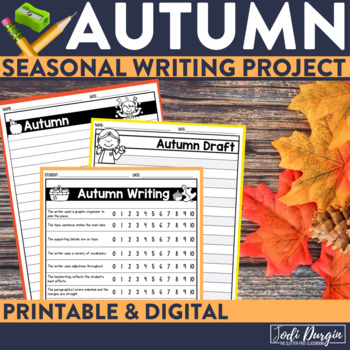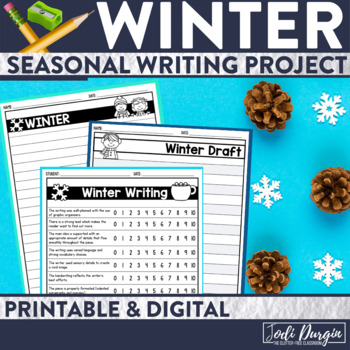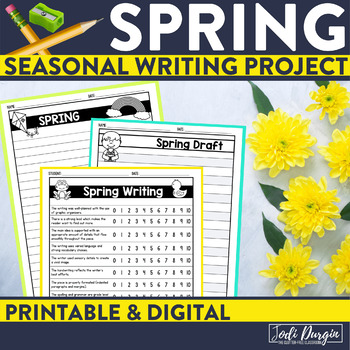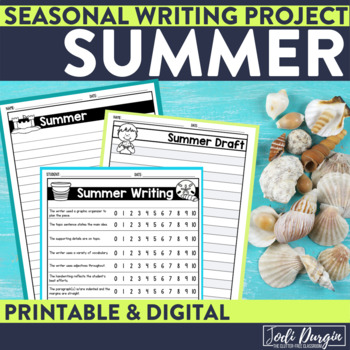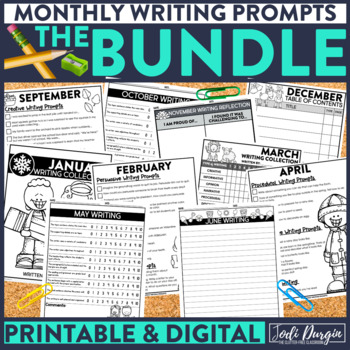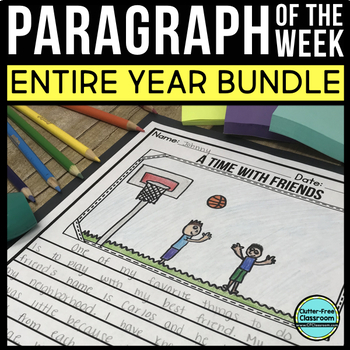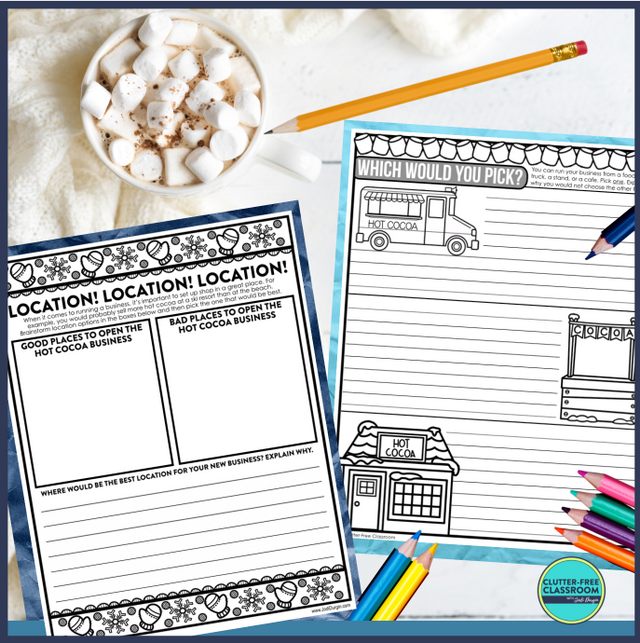This post is all about how to teach writing to elementary students using the 6 steps of the writing process. Your students will be entering your classroom with a diverse set of writing skills at the start of the school year, which is why administering a formative assessment the first month of school will be so important. You’ll be able to quickly identify students’ strengths and weaknesses. This information will help you design whole group and small group lessons based on your students’ needs.

The seasonal writing bundle will help you collect this data at the start of the school year, as well as periodically through the year! It includes a writing formative assessment for each of the four seasons:
- Autumn Writing Formative Assessment
- Winter Writing Formative Assessment
- Spring Writing Formative Assessment
- Summer Writing Formative Assessment
At the end of the school year, you’ll have four writing samples that show your students’ growth in writing. These writing samples are great for sharing with parents during conferences. You can also share them with your students’ teacher for the following school year. They are a great way to compare their writing from the different parts of the year because they follow the same format, which allows you to compare apples to apples. This is a great resource for your whole team, or better yet, your whole school to do.
This blog post will explain how to teach writing to elementary students using the 6 steps of the writing process and will share more information about these writing assessments for elementary students.
6 Steps of the Writing Process
Here is some information about the six steps of the writing process, which is also called the 6 stages of writing. This information will help you with how to teach the writing process to elementary students.
1. Pre-Writing
The first step of the writing process is pre-writing. Prewriting involves considering purpose for writing, brainstorming ideas, using graphic organizers to connect those ideas, and designing a coherent structure. There are different ways to work through the prewriting phase and it is important to identify which is best for your students.
It is often helpful to engage students in a whole-class brainstorming session to come up with ideas to get them started. You could instead have them brainstorm general ideas in small groups. Graphic organizers help all students to organize their ideas during the prewriting stage. We’ve included a variety of options for you to choose from in our seasonal writing bundle resources.
2. Planning and Organizing
The second step of the writing process is planning and organizing. I recommend using a top-down web. A top-down web is a graphic organizer that presents topics and sub-topics in a hierarchical way, using varied shapes and placement on the page to represent the connections among the topics.
It is often used to improve reading comprehension to frame students’ thoughts and help them to understand the information they are reading. They also work amazingly well as a tool for designing the structure of writing.
There are five different styles of top-down webs included in this seasonal writing packet. Some include lines to help with fine motor skills while others are open. There are also options for simple and more complex paragraphs as well as multi-paragraph essays. Select the one that is best for your students. You can easily differentiate to meet their varied needs by using multiple styles within your classroom.
3. Drafting
The third step of the writing process is drafting. Students work independently at this stage. As they write their drafts, circulate the room, confer with each of them and offer constructive criticism. Observe areas with which students show challenge and informally assess areas in which an individual conference, small group intervention, or a whole class mini-lesson would be beneficial. The seasonal writing packet includes three options for drafting.
4. Revising and Editing
The fourth step of the writing process is revising and editing. This is best done in a 1:1 conference between the student writer and an adult. Teach students to reread their own work more than once as they think about whether it really conveys what they want to tell their reader. Reading their work aloud to classmates and other adults helps them to understand what revisions are needed.
Show students how to revise specific aspects of their writing to make it more coherent and clear. You can model reading your own writing and do a think-aloud about how you could add more details and make it clearer in a mini lesson.
Be cautious not to “over-correct” a student’s writing, but instead certain areas to focus on during each editing session.
Set goals for your students and assess them on their progress in those areas. Teach them how to be resourceful in finding the correct spelling of misspelled words.
5. Rewriting
The fifth step of the writing process is rewriting. Have your students incorporate the changes discussed during your writing conference as they carefully rewrite their drafts.
If you are using the seasonal writing printables, then select the final copy stationary that is best for each student. There are two options of each stationary style. The first has a black bar with white text and the other is a printer-friendly version.
6. Publishing
The final step of the writing process is publishing. There are a variety of ways to publish student writing, but the seasonal writing pages were designed specifically to help showcase additional measures of student growth and progress. Have them illustrate a scene to supports their paragraph at the bottom of the page. Encourage them to do their personal best.
Add a photo of the student taken in that season to the top section. If you live in an area with four seasons, we recommend taking the photos outside to reflect each season. At the school I taught at in Massachusetts, there was a beautiful tree on the property. It served as the perfect location for taking students’ pictures for this activity. The tree changed with the seasons. If you live in a climate that lacks major seasonal changes, you could use fun props to create a “photo booth” for each season.
When you use our full-year seasonal writing portfolio option and include these drawing and photos it really shows how much a child changes and advances throughout your time together. This is a wonderful way to document progress and provides a precious keepsake your students’ families will cherish in the future.
It’s important to note that each one can stand on its own. This means you can use it with your students without administering the others. For example, you can just use the fall and spring ones to show students’ growth from the beginning of the year to the end. You do not have to use all four of the elementary writing assessments. You can decide what works best for you and your classroom.
3 Resources for Teaching Writing
I hope you found this information about how to teach writing to elementary students through the 6 steps of the writing process helpful! If you need resources for assessing your students’ progress throughout the school year, then I highly recommend checking out the resources below.
1. Quarterly Writing Assessments
The seasonal writing bundle includes 4 writing formative assessments. You can learn more about the resources in the Winter Writing Assessment blog post and Spring Writing Assessment blog post. They also provide additional information about how to teach elementary writing. Check out the resources below!
- Autumn writing assessment
- Winter writing assessment
- Spring writing assessment
- Summer writing assessment
- Bundle of all 4 writing assessments
2. Monthly Writing Prompts
These monthly writing prompts are a great fast finisher activity and writing center. Students love using the prompts to craft unique stories and parents love to see how their child’s writing grows throughout the school year.
3. Paragraph of the Week Writing
In addition, you may find these Paragraph of the Week helpful for how to teach the writing process to elementary students. Paragraph of the Week is a proven, step-by-step, scaffolded system. It makes teaching kids how to improve sentence structure and write a paragraph easy by guiding them through the writing process. This resource pairs perfectly with the seasonal writing resources. Learn more about it in this post all about paragraph of the week!



